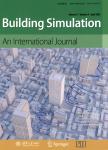Numerical studies on swirling of internal fire whirls with experimental justifications
作者机构:Midea Residential Air Conditioner DivisionFoshanGuangdongChina College of Aerospace and Civil EngineeringHarbin Engineering UniversityHarbinHeilongjiangChina Department of Building Services EngineeringThe Hong Kong Polytechnic UniversityHunghomKowloonHong KongChina
出 版 物:《Building Simulation》 (建筑模拟(英文))
年 卷 期:2021年第14卷第5期
页 面:1499-1509页
核心收录:
学科分类:080704[工学-流体机械及工程] 080103[工学-流体力学] 08[工学] 0807[工学-动力工程及工程热物理] 0801[工学-力学(可授工学、理学学位)]
基 金:sponsored by the National Natural Science Foundation of China(No.11402061) The work described in this paper was also partially supported by a grant from the Research Grants Council of the Hong Kong Special Administrative Region,China,for the project“A study on electric and magnetic effects associated with an internal fire whirl in a vertical shaft”(Project No.PolyU 15206215)with account number B-Q47D
主 题:internal fire whirl large eddy simulation vertical structure flame surface
摘 要:Numerical studies on internal fire whirls(IFW)generated in a vertical shaft model with a single corner gap were reported in this *** generation of IFW,burning rate of fuel and temperature were studied experimentally *** simulations on medium-scale IFW were carried out using a fully-coupled large eddy simulation incorporating subgrid scale turbulence and a fire source with heat release rates compiled from experimental *** transient flame shape was studied and then simulated numerically by using *** dynamic phenomena of generation and development of IFW were simulated and then compared with experimental *** predicted results were validated by comparing with experimental data,which demonstrated that an IFW can be simulated by Computational Fluid *** results for flame surface,temperature,and flame length agreed well with the experimental *** IFW flame region and intermittent region were longer than those for an ordinary pool *** modified empirical formula for centerline temperature was *** of vertical and tangential velocity in axial and radial directions were also *** vortex core radius was found to be determined by the fuel bed *** field was not measured extensively due to resources *** measured temperature distribution with predictions is acceptable because temperature is related to the heat release rate,air flow and pressure gradient.



